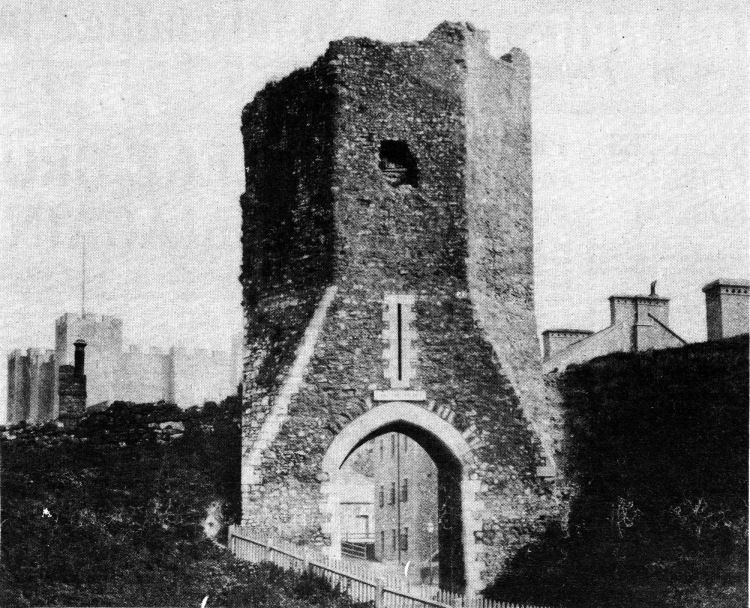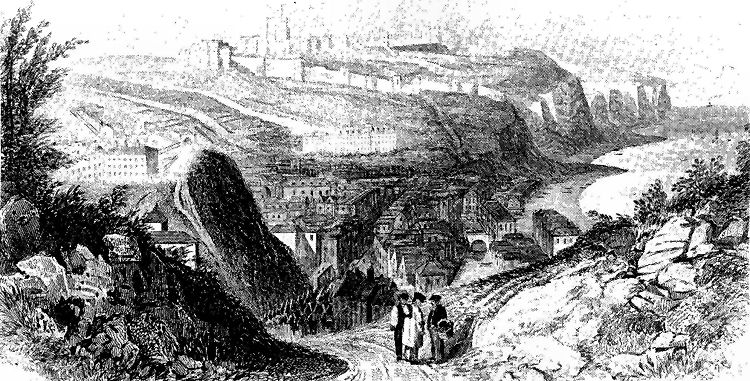Page Updated:- Sunday, 07 March, 2021. |
|||||
 Published in the Dover Express, 12 September, 1980. A PERAMBULATION OF THE TOWN, PORT AND FORTRESS. PART 113.
THE DROP REDOUBT The Drop Redoubt, on the highest point of the brow of the hill overlooking the town, is where the Roman tower stood. The works of fortification have long since removed all outward trace of the old Bredenstone, but when excavations were being made here for further fortifications in May, 1861, Mr. Clement Tait, the engineer in charge of the works, discovered the foundations of the Roman Pharos tower. That gentleman, who had promised the Kent Archaeological Society that he would make careful observations when digging at that historic spot, wrote: " While excavating at the Drop Redoubt, at a depth of about 15 feet, my attention was drawn to a piece of masonry which, upon inspection of its component parts, showed it to have been built at a very remote age and, on further examination, it proved to be the foundation of a Roman Pharos.“ Portions of the masonry were left entire in the walls of the casemates. Some large fragments of the conglomerate material were brought up. and two of the pieces were on view when the installation of the Marquis of Dufferin and Ava took place there in 1892. It is not possible now, without special arrangements to see any part of the Bredenstone. Proceeding further westward, beside the road which leads to the Citadel, between the Garrison Church and the South Front Barracks, may be seen the foundations of the ancient Church of the Holy Sepulchre. To those who have seen the entire churches of this description at London, Cambridge, etc., this outline of the foundations is not much to look at, but the interest is increased by remembering the fact that the house of the Templars stood near the same spot, and that in all probability, it was here that King John made subjection to the Pope of Rome. Historians tell that: “On the 15th of May, 1213, at an early hour of the morning, John repaired to the Church of the Templars at Dover, and there, surrounded by Bishops, Barons and Knights, took on his knees, before Pandulph, the Pope’s Legate, an oath of fealty to the Pope, at the same time placing in the Envoy's hands a charter testifying that he, the King of England and Lord of Ireland, in atonement for his offences against God and the Church, with the general consent of his Barons, surrendered the Kingship of England and the Lordship of Ireland, which should henceforth be held as fiefs of the Holy See. paying an annual tribute of 700 marks for England, and 300 marks for Ireland.
DOVER FORTIFICATIONS Military science has, from time to time, been employed to fortify the natural strength of the hills of Dover. The principal fortifications of the interior of the Castle are ancient or medieval, and are now practically obsolete. The accommodation for troops both in the old casemates and in modern barracks was for many years in the 19th century used as quarters for No. 1 Depot of the Royal Garrison Artillery and there were usually three companies of the Royal Artillery quartered there. But in 1908 they moved elsewhere. After the Kaiser War Langdon Battery became the headquarters of the Royal Artillery. Facing the sea, in front of the Roman works, a very handsome terrace of officers’ quarters, constructed of Kentish rag. was built in the year 1857; and, in 1891. were added, in the same style, huts for the better housing of the Royal Artillery, who had previously been accommodated in the cliff casemates.

A century old photograph of Colton Tower or Gate, at Dover Castle by the Biggin Street photographer Martin Jacolette who had a studio where the gas showrooms are today. In Saxon times this was the only entrance to the Castle fortifications. The only Saxon tower left standing at the Castle, it is said to have been committed to the care of Fulbert de Dover who appointed an officer to keep guard in It and granted lands at Chilham to provide Income for that purpose.

The 19th century engraving below gives a view of Dover from the Western Heights with Grand Shaft Barracks above Snargate Street, on the left. Nearer the foreground is the tower and rooftop of what looks like a church or chapel. Marching down the hill are soldiers from the Citadel barracks.
|
|||||
|
If anyone should have any a better picture than any on this page, or think I should add one they have, please email me at the following address:-
|
|||||
| LAST PAGE |
|
MENU PAGE |
|
NEXT PAGE | |